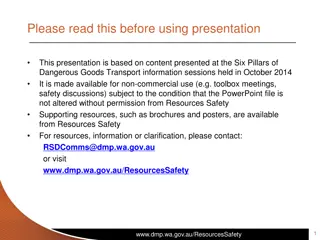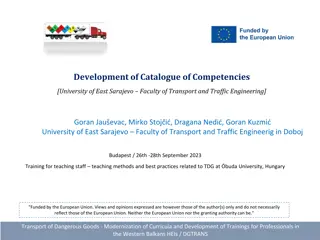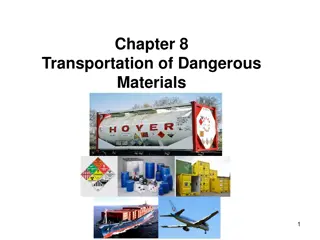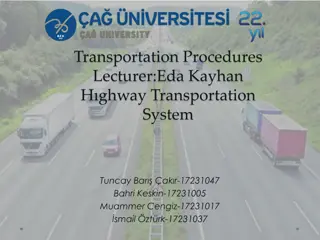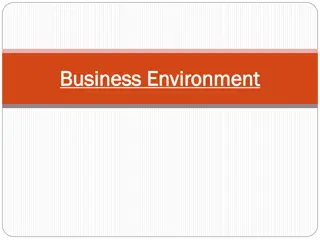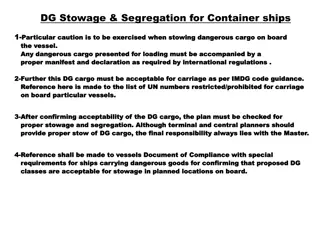Enhancing Professional Competencies in Transporting Dangerous Goods
The training aims to develop key competencies essential for safe transportation of dangerous goods, including regulatory knowledge, classification, packaging, labeling, documentation, emergency response, and more. Participants will learn about important practices and methods to ensure compliance with regulations and safety standards in handling hazardous materials.
- Transporting Dangerous Goods
- Professional Competencies
- Training Methods
- Safety Standards
- Hazardous Materials
Download Presentation

Please find below an Image/Link to download the presentation.
The content on the website is provided AS IS for your information and personal use only. It may not be sold, licensed, or shared on other websites without obtaining consent from the author. Download presentation by click this link. If you encounter any issues during the download, it is possible that the publisher has removed the file from their server.
E N D
Presentation Transcript
Presentation title Presentation title Dr. Flora Krasniqi POLIS University Budapest / 26th -28th September 2023 Training for teaching staff teaching methods and best practices related to TDG at buda University, Hungary "Funded by the European Union. Views and opinions expressed are however those of the author(s) only and do not necessarily reflect those of the European Union. Neither the European Union nor the granting authority can be." Transport of Dangerous Goods - Modernization of Curricula and Development of Trainings for Professionals in the Western Balkans HEIs / DGTRANS Call: ERASMUS-EDU-2022-CBHE-STRAND-2 Project number: 101082187
Professional competencies in the transport of dangerous goods are essential for individuals and organizations involved in the transportation, handling, and management of hazardous materials. These competencies ensure the safe and compliant transportation of dangerous goods, which is critical to preventing accidents, protecting the environment, and safeguarding public health. Transport of Dangerous Goods - Modernization of Curricula and Development of Trainings for Professionals in the Western Balkans HEIs / DGTRANS
Some key professional competencies in this field: Regulatory Knowledge: Understanding and staying up-to-date with local, national, and international regulations governing the transportation of dangerous goods is fundamental. Classification: Competency in classifying hazardous materials based on their physical and chemical properties, as well as their potential risks, is crucial. This involves identifying the appropriate hazard class, division, and packing group for each material. Packaging: Understanding the proper packaging requirements for different hazardous materials, including selecting suitable containers, drums, or packages, is essential. Labeling and Marking: Proficiency in labeling and marking packages with the correct hazard labels, placards, and markings according to regulatory standards is vital for communication and safety during transportation. Transport of Dangerous Goods - Modernization of Curricula and Development of Trainings for Professionals in the Western Balkans HEIs / DGTRANS
Documentation: Accurate and complete documentation, including shipping papers and manifests, is essential for tracking and tracing dangerous goods. Safety Data Sheets (SDS): Familiarity with Safety Data Sheets (SDS) and the ability to interpret them is necessary for understanding the hazards associated with specific dangerous goods and taking appropriate safety measures. Transportation Modes: Understanding the specific requirements and safety considerations for transporting dangerous goods by various modes (e.g., road, rail, air, sea) is essential. Each mode has unique regulations and precautions. Emergency Response: Competence in emergency response procedures, including how to respond to spills, leaks, fires, or accidents involving dangerous goods, is vital to minimize risks and protect responders and the environment. Transport of Dangerous Goods - Modernization of Curricula and Development of Trainings for Professionals in the Western Balkans HEIs / DGTRANS
Security Measures: Being aware of and implementing security measures to prevent unauthorized access to or tampering with dangerous goods during transport is a crucial part of professional competencies. Training and Certification: Continuous training and certification in dangerous goods transportation is essential. Professionals should stay current with changing regulations and best practices through regular education and training programs. Environmental Responsibility: Competence in managing hazardous waste generated during the transport of dangerous goods, including proper disposal and recycling, is essential to minimize environmental impact. Communication: Effective communication with all stakeholders, including shippers, carriers, emergency responders, and regulatory authorities, is crucial for ensuring the safe transport of dangerous goods. Transport of Dangerous Goods - Modernization of Curricula and Development of Trainings for Professionals in the Western Balkans HEIs / DGTRANS
Risk Assessment: The ability to conduct risk assessments to evaluate potential hazards and develop mitigation strategies is a key competency, particularly for organizations involved in large-scale transportation of hazardous materials. Record Keeping: Proper record-keeping practices, including retaining documentation related to dangerous goods shipments, is essential for compliance and accountability. Crisis Management: Being prepared to manage crisis situations, such as accidents or spills, is a critical competency to minimize damage and protect public safety. Transport of Dangerous Goods - Modernization of Curricula and Development of Trainings for Professionals in the Western Balkans HEIs / DGTRANS
Thank you! Transport of Dangerous Goods - Modernization of Curricula and Development of Trainings for Professionals in the Western Balkans HEIs / DGTRANS


